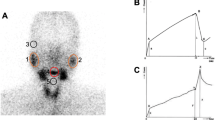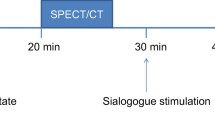Abstract
Objective
The aim of this study was the assessment of semi-quantified salivary gland dynamic scintigraphy (SGdS) parameters independently and in an integrated way in order to predict primary Sjögren’s syndrome (pSS).
Materials and methods
Forty-six consecutive patients (41 females; age 61 ± 11 years) with sicca syndrome were studied by SGdS after injection of 200 MBq of pertechnetate. In sixteen patients, pSS was diagnosed, according to American-European Consensus Group criteria (AECGc).
Semi-quantitative parameters (uptake (UP) and excretion fraction (EF)) were obtained for each gland. ROC curves were used to determine the best cut-off value. The area under the curve (AUC) was used to estimate the accuracy of each semi-quantitative analysis.
To assess the correlation between scintigraphic results and disease severity, semi-quantitative parameters were plotted versus Sjögren’s syndrome disease activity index (ESSDAI). A nomogram was built to perform an integrated evaluation of all the scintigraphic semi-quantitative data.
Results
Both UP and EF of salivary glands were significantly lower in pSS patients compared to those in non-pSS (p < 0.001). ROC curve showed significantly large AUC for both the parameters (p < 0.05).
Parotid UP and submandibular EF, assessed by univariated and multivariate logistic regression, showed a significant and independent correlation with pSS diagnosis (p value <0.05). No correlation was found between SGdS semi-quantitative parameters and ESSDAI. The proposed nomogram accuracy was 87%.
Conclusion
SGdS is an accurate and reproducible tool for the diagnosis of pSS. ESSDAI was not shown to be correlated with SGdS data.
Clinical relevance
SGdS should be the first-line imaging technique in patients with suspected pSS.




Similar content being viewed by others
References
Vinagre F, Santos AI, Santos MJ et al (2008) Salivary gland scintigraphy in the evaluation of patients with sicca complaints. Acta Reumatol Port 33:422–428
Zou Q, Jiao J, Zou M-H et al (2012) Semi-quantitative evaluation of salivary gland function in Sjögren’s syndrome using salivary gland scintigraphy. Clin Rheumatol 31:1699–1705
Klutmann S, Bohuslavizki KH, Kröger S et al (1999) Quantitative salivary gland scintigraphy. J Nucl Med Technol 27:20–26
Ramos-Casals M, Brito-Zerón P, Perez-De-Lis M et al (2010) Clinical and prognostic significance of parotid scintigraphy in 405 patients with primary Sjögren’s syndrome. J Rheumatol 37:585–590
Vitali C, Bombardieri S, Jonsson R et al (2002) Classification criteria for Sjögren’s syndrome: a revised version of the European criteria proposed by the American-European Consensus Group. Ann Rheum Dis 61:554–558
Henriksen AM, Nossent HC (2007) Quantitative salivary gland scintigraphy can distinguish patients with primary Sjögren’s syndrome during the evaluation of sicca symptoms. Clin Rheumatol 26:1837–1841
Shizukuishi K, Nagaoka S, Kinno Y et al (2003) Scoring analysis of salivary gland scintigraphy in patients with Sjögren’s syndrome. Ann Nucl Med 17:627–631
Adams BK, Al Attia HM, Parkar S (2003) Salivary gland scintigraphy in Sjögren’s syndrome: are quantitative indices the answer? Nucl Med Commun 24:1011–1016
Aung W, Murata Y, Ishida R et al (2001) Study of quantitative oral radioactivity in salivary gland scintigraphy and determination of the clinical stage of Sjögren’s syndrome. J Nucl Med 42:38–43
Vivino FB, Hermann GA (2008) Role of nuclear scintigraphy in the characterization and management of the salivary component of Sjögren’s syndrome. Rheum Dis Clin N Am 34:973–986
Seror R, Ravaud P, Bowman SJ et al (2010) EULAR Sjögren’s syndrome disease activity index: development of a consensus systemic disease activity index for primary Sjögren’s syndrome. Ann Rheum Dis 69:1103–1109
Loutfi I, Nair MK, Ebrahim AK (2003) Salivary gland scintigraphy: the use of semiquantitative analysis for uptake and clearance. J Nucl Med Technol 31:81–85
Umehara I, Yamada I, Murata Y et al (1999) Quantitative evaluation of salivary gland scintigraphy in Sjorgen’s syndrome. J Nucl Med 40:64–69
Parrago J, Rain J, Brocheriou C et al (1987) Scintigraphy of the salivary glands in Sjögen’s syndrome. J Clin Pathol 40:1463–1467
Kim HA, Yoon SH, Yoon JK et al (2014) Salivary gland scintigraphy in Sjögren’s syndrome. Comparison of the diagnostic performance of visual and semiquantitative analysis. Nuklearmedizin 53:139–145
Güne S, Yilmaz S, Karalezli A et al (2010) Quantitative and visual evaluation of salivary and thyroid glands in patients with primary Sjögren’s syndrome using salivary gland scintigraphy: relationship with clinicopathological features of salivary, lacrimal and thyroid glands. Nucl Med Commun 31:666–672
Anjos DA, Etchebehere EC, Santos AO, et al. (2006) Normal values of [99mTc]pertechnetate uptake and excretion fraction by major salivary glands. Nucl Med Commun 27:395–403.ss
Acknowledgements
The authors would like to thank Prof Alessandro Giordano for his helpful suggestions and the Nuclear Medicine staff for their support as well as Eda Koxhaku for the English editing.
Author information
Authors and Affiliations
Corresponding author
Ethics declarations
Conflict of interest
The authors declare that they have no conflict of interest.
Funding
Financial funding was not required nor obtained: this research received no specific grant from any funding agency in the public, commercial or not-for-profit sectors.
Ethical approval
All procedures performed in studies involving human participants were in accordance with the ethical standards of the institutional and/or national research committee and with the 1964 Helsinki declaration and its later amendments or comparable ethical standards.
Informed consent
Informed consent was obtained from all the individual participants included in the study.
Rights and permissions
About this article
Cite this article
Angusti, T., Pilati, E., Parente, A. et al. Semi-quantitative analysis of salivary gland scintigraphy in Sjögren’s syndrome diagnosis: a first-line tool. Clin Oral Invest 21, 2389–2395 (2017). https://doi.org/10.1007/s00784-016-2034-6
Received:
Accepted:
Published:
Issue Date:
DOI: https://doi.org/10.1007/s00784-016-2034-6




